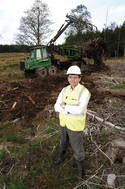Fuels for thought
29 May 2010As forecasters warn that wood fuel demand in the UK could outstrip supply, UPM is exploring alternative sources. UPM Tilhill timber operations director Peter Whitfield reports
Summary
¦ UPM has built 12 biomass mills since 1990.
¦ Its annual biomass energy generation is 1.6GW.
¦ In the UK it has spent £120m on biomass combined heat and power plant.
¦ To supplement biomass supplies it is evaluating use of brash.
¦ Stump harvesting is also being explored.
There is no doubt that the matter of biomass is still a hot topic! There has been a clear increase in demand both commercially and domestically as consumers and producers see the benefits of wood as a fuel, whether as a result of government-backed biomass energy incentives or the more immediate impact of increasing domestic oil costs and the direct impact on the domestic user’s pocket.
The biggest concern for the domestic timber processing industry is that, as these drivers increase demand for woody biomass, demand will rapidly outstrip supply.
Industry report
Earlier this year industry bodies commissioned John Clegg Consulting Ltd to produce a report – Wood Fibre Availability and Demand in Britain 2007-2025. It highlights in detail the supply and demand balance in Britain, both in total and regionally. The report concludes: “If new large users of British-grown wood and other wood fibre enter the market place, supported by subsidy, then it can only be at the expense of existing users, impacting negatively and disproportionately on sustainability, employment, carbon sequestration and mitigation of climate change.” There are several plans for large biomass-based projects some planned for imported biomass. In all of these the access to biomass is the key question.
UPM itself has a large low-carbon energy portfolio. This includes nine hydro power plants in Finland and 12 biomass combined heat and power (CHP) plants that have been built since 1990. Total electricity generating capacity is approximately 1.6GW. Recently UPM rebranded as the ‘Biofore’ company, illustrating the integration of the bio and forest industries. The company has already developed a number of future business areas under this concept such as biodiesel production. And in the UK, UPM has invested £120m in renewable CHP plants, with its forest management operation UPM Tilhill as dedicated supply managers.
In setting up the supply streams for the UK plants UPM Tilhill reviewed a number of virgin biomass options. Clearly the burning of small roundwood alone is not the best use of this product and other opportunities were investigated. This took us to examining brash and stump harvesting options. UPM in Finland had already gained considerable experience in this area. For UK operations brash and stump harvesting protocols were developed to ensure a thorough and professional process was followed. UPM Tilhill commissioned a literature review and life cycle assessment (LCA) carried out by renewables, a spin out company from Bangor University.
Residue harvesting
In addition, work was undertaken jointly with other private sector companies, SEPA and FC to develop and share results on residue harvesting. This work fed into the FC’s own Guidance Note on site selection and best practice. The assessment of sites for stump harvesting revealed that there were relatively few sites in the UK that were suitable. UPM Tilhill also supported investments by our contractors in equipment for harvesting and haulage of both brash and stumps.
The UPM Tilhill operational controls and FC guidance highlight that best practice for brash and stumps harvesting should operate on mineral soils only, avoiding organic rich soils. No more than 60% brash or stumps should be removed.
From the LCA, which compared wood fuel harvesting systems against a coal fuel reference system, it was clear that wood fuel systems offered at least a 60% improvement over coal in terms of carbon balance. All forest biomass systems complied with the minimum greenhouse gas savings stipulated in the Renewable Energy Directive (2009/28/EC) of 60% by 2018. Soil carbon changes have a far greater effect on carbon emissions than the combination of all other inputs. Roundwood fuel systems made a positive contribution to lowering greenhouse gas emissions, with no negative impacts on soil carbon.
Looking to the future, brash harvesting certainly provides a viable biomass fuel alternative to roundwood but uncertainties remain regarding the impact that stump harvesting could have on short- and long-term soil greenhouse gas emissions and further research is required. The determination of future supplies will take into account the complex assessment of market, cost and environmental factors.


